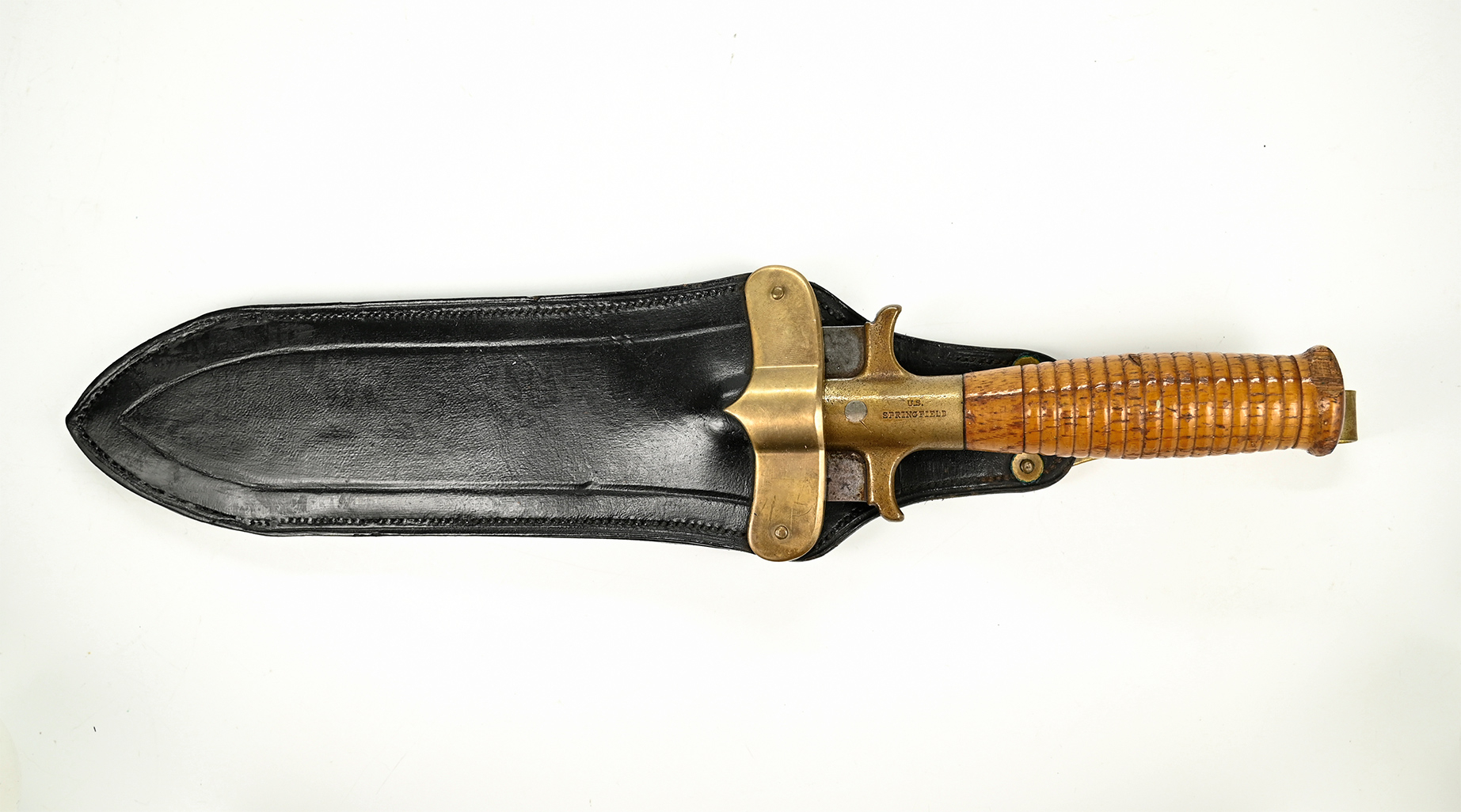site search
online catalog
VERY GOOD US MODEL 1880 HUNTING KNIFE

$575.00 SOLD
Quantity Available: None
Item Code: 169-630
This regulation knife has a blade with good edges and point, smooth metal, with just some thin age stains to the blade, handle, and guard, with a few tiny dings to the latter, and just a minor chip to the brim of the pommel. The blade shows as a muted silver gray and the grip is a pleasing light brown. The markings are sharp on guard, and in the minty black leather body of the scabbard. The riveted brass belt hook and throat plate are both in place. These wide-bladed knives were intended to be multi-purpose. Butchering game and various duties around camp were the main concerns. One veteran praised them since up to that time, “whenever we went out on campaign we had to provide ourselves with hunting or butcher knives at our own expense. (Government bacon being too strong or tough for the ordinary case-knife.)” When not battling government rations, however, they might also be used for entrenching, something increasingly stressed in tactics, and were deemed effective enough for that purpose that the trowel bayonet was declared obsolete in late 1881, though it was another ten years before the knife was redesignated as an entrenching tool in 1892.
These were produced in two variations of the knife and five for the scabbard. The overall form of the knife did not change: it used an 8.5 inch blade, 2-inches wide, with a spear point and median ridge. The handle was maple, cylindrical, with grooved grip and flat overhanging pommel for a secure grip. The first 1,000 produced, completed in early 1881, used an iron guard and handle socket. Another round of production began in early 1883, but used brass guards that could be made at Springfield. This subsequent production was done in two batches of 5,000 knives each and each batch separately numbered from 1 to 5,000. This is from one of those two batches and has a brass guard clearly stamped “US / SPRINGFIELD” on one side of the handle socket and serial numbered “4740” on the other. (A final group, made after the 1892 redesignation, numbered just 500 and was not serial numbered.)
The scabbard on this knife is clearly stamped by Rock Island Arsenal uses the final form with a fixed, flat brass hook to fasten over a cartridge belt, where earlier patterns were envisioned as using a simple waist belt and used a hinged clamp or a narrow leather belt loop. Once carrying it on the cartridge belt was approved a larger loop was introduced in 1887, changed to a brass hook and swivel in 1888, as used on the bayonet scabbard. Only in February 1890 was it realized the swivel was unnecessary and the brass hook alone authorized. This was produced at both Watervliet and Rock Island Arsenals, and applied by the simple expedient of cutting off the loops of the older leather loop scabbards, sewing the resulting short tabs together and riveting on the brass belt hook.
This is a nice example of how the army tried to adapt its equipment not only to different environments, but to changing tactical doctrines as the age of the muzzle-loader gave way to longer range and more rapid fire weapons, leading to the increased use of improvised field works and rifle pits. [SR] [ph:m]
~~~~~~~~~~~~~~~~~~~~~~~~~~~~~~~~~~~
THIS ITEM, AS WITH ALL OTHER ITEMS AVAILABLE ON OUR WEB SITE,
MAY BE PURCHASED THROUGH OUR LAYAWAY PROGRAM.
CLICK HERE FOR OUR POLICIES AND TERMS.
THANK YOU!
Inquire About VERY GOOD US MODEL 1880 HUNTING KNIFE
For inquiries, please email us at [email protected]
Most Popular
Historical Firearms Stolen From The National Civil War Museum In Harrisburg, Pa »
Theft From Gravesite Of Gen. John Reynolds »
Selection Of Unframed Prints By Don Troiani »
Fine Condition Brass Infantry Bugle Insignia »
British Imported, Confederate Used Bayonet »
Scarce New Model 1865 Sharps Still In Percussion Near Factory New »
featured item
VERY RARE CONFEDERATE “ROPE BORDER” BELT PLATE
Dug condition stamped brass oval “rope border” belt plate. Unlike their US counterparts, these were not lead filled. These are not commonly found and can most often be traced back to the contractor Magee and George of New Orleans. The firm of… (1202-260). Learn More »
site search
Upcoming Events
APRIL 12-13: SPRING GETTYSBURG MILITARY ANTIQUES SHOW; All Star Events Complex Learn More »










